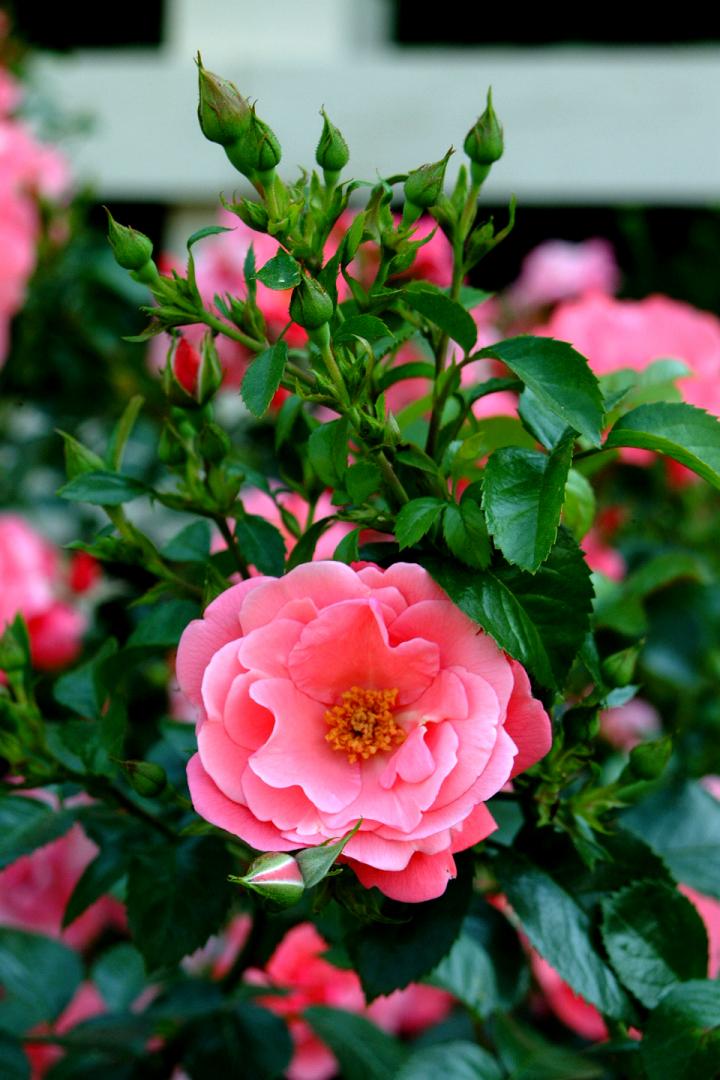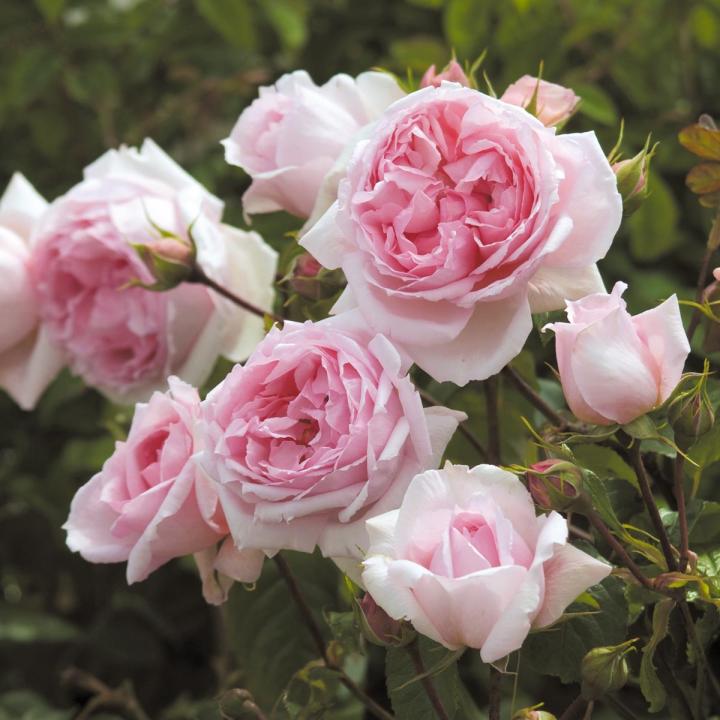Info on low maintenance rose types: David Austin roses, Knockout Roses, Carpet Flower roses.
by Doreen Howard
Today’s roses are no longer intimidating prima donnas! Discover easy-to-grow rose varieties —from Flower Carpet ground cover roses to Knock Out shrub roses to David Austin old-fashioned rose climbers. They shrug off pests and diseases and bring years of classic beauty. You can truly plant and almost forget about them! |
| | Gone are the finicky, high-maintenance plants which required endless pruning, spraying, and dusting. Now all you do is plant, fertilize, and water. Your reward is healthy, beautiful bushes loaded with fragrant blooms for cutting and landscaping all summer long. Gorgeous!! |  | LET’S HIGHLIGHT THREE TYPES OF ROSES THAT ARE EASY TO GROW AND MAINTAIN:
EASY GROUND COVER ROSES
Ground cover roses are extraordinarily low-maintenance and have exceptional disease resistance. They’re also versatile and can be used in mixed borders, low hedges, hanging baskets, and large containers.
The Flower Carpet® roses are the world’s number one ground cover rose and incredibly prolific blooms. They have a unique double root system (they have deep roots as well as soil-surface roots) that makes them able to tolerate weather conditions. They don’t get too bushy (probably no more than two feet high) and tend to stay low to the ground in more of that ground cover habit.
As for pruning, once a year in late winter or early spring, all you need is a pair of garden shears to cut them back by a third any which way. This is the rose that needs no guessing, no worrying. |  | | Flower Carpet® roses come in many colors and repeat bloomers. Some varieties produce up to 2,000 flowers a season! |  | | Flower Carpet® roses survive drought, heavy rain storms, and humid weather which has destroyed less resilient roses. | EASY SHRUB ROSES
Shrub roses and those grown on their own roots are also the best choices, especially for cold climates. I’ve lost dozens of hybrid teas to -25ºF winters, no matter how much mulch I heaped upon the plants. These same roses also stand up to heat, humidity, and the myriad diseases spawned by hot climates. I know, firsthand, because I’ve lived and grown roses in places from the Gulf Coast to Wisconsin. |  | | Landscape roses such as these Knock Outs make for stunning color all season long with minimal care. |  | | Another shrub rose I adore is Lady Elsie May. It’s a tough shrub and flowered nonstop in my Zone 4b garden for the last 7 years. I don’t even water it! Rainfall seems to be enough. Courtesy of Angelica Nurseries. | Compost mulch every spring is the only maintenance my shrub roses require.
EASY CLIMBING ROSES
Then, there are some superb climbing roses. Unlike many climbing roses, the English Rose Climbers by David Austin repeat flower with exceptional continuity and are clothed in blooms from the ground upwards. As a group, they don’t grow too tall, making them easy to manage and the perfect height for appreciating the beauty and fragrance of their blooms. |  | | Image: David Austin English Rose Climbers have fragrance and charm | BARE-ROOT OR CONTAINER ROSES?
All these easy-care roses come in two types: 1) bare-root and 2) container-grown. There are pros and cons to which type you buy: - Bare-root roses: Bare-root roses are not in soil (hence, “bare”) and packed to prevent the roots drying out . Bare-root plants are usually good quality, having a wider root spread than container plants, and they are often good value. They should be planted as soon as received, or if ground conditions are unsuitable, unpacked and kept in a container of slightly moist compost and planted as soon as conditions allow.
Plant bare-root roses in late autumn at leaf fall, and from late winter to early spring, before growth resumes. Avoid planting in the middle of winter when the ground is frozen.
Soak bare root roses in a bucket of warm water overnight. Then dig a hole 18 inches wide and deep. Mix in compost or peat moss if your soil is hard and compacted. In the center of the hole, make a 12-inch-high cone of dirt. Spread rose roots over the cone. Hold rose in place with one hand and fill in the hole with the other. Firm soil and water well.
- Container-grown roses: These are roses that have been grown in containers for a whole growing season or more. They can be more costly but also available all year round. And you can plant all year round, provided the ground is neither frozen, nor very dry. If you are in southern zones, container roses are the best choice, because your ground and air temperatures are warmer.
Dig a hole the depth of the rose pot and 18 inches wide. Remove the plant from pot, place in center of the hole, spread roots, and fill in with soil. Water well and firm soil with the back of a shovel or your hands to eliminate air pockets. Scatter slow-release fertilizer formulated for roses around plants and scratch in with a cultivator. 5 ROSE TIPS THAT REALLY WORK - Plant lavender at the base of rosebushes if deer are a problem in your area. Deer are attracted by rose scent, and lavender muddies the rose aroma.
- Dump coffee grounds and used tea leaves around bushes. Both acidify the soil slightly, which roses love.
- Bury banana skins or even the entire black, mushy banana at the base of bushes to provide magnesium, an element that the plants crave.
- Scratch 2 tablespoons of Epsom salts into the soil around a rose. The salts make flower colors more intense.
- Use rabbit food for fertilizer. The pet food is composed of alfalfa meal, which supplies a growth stimulant, nitrogen, and trace elements to roses. Scratch in ½ cup of pellets around each rose and water well.
|
|
| | | | Visit Almanac.com Shop Our Store | © 2020 Yankee Publishing Inc. All rights reserved.
View web version
You received this email because you signed for updates from The Old Farmer's Almanac.
To manage your preferences or unsubscribe click here. |
|
| | |











No comments:
Post a Comment